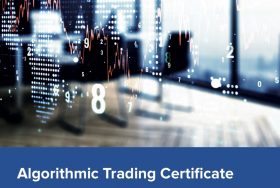
Syllabus
- Provide a strong foundation in the tools and techniques used in algorithmic trading.
- Cover everything from basic programming concepts to advanced trading strategies and methods for research into new alpha sources.
- Apply everything in hands-on projects throughout the course.
12 Lecture Weeks:
- Module 1: Intro and Industry Overview
- Module 2: Data and Features
- Module 3: Statistics and Time Series
- Module 4: Machine Learning
- Module 5: Trend Following
- Module 6: Carry and Volatility Strategies
- Module 7: Mean Reversion
- Module 8: Forecasting Models and Factor Investing
- Module 9: Order Execution and Market Making
- Module 10: Portfolio Theory and Allocation
- Module 11: Backtesting and Performance
- Module 12: Risk Management
Course Content:
1 Intro and Industry Overview
- 1.1 Trading Basics
- 1.2 Industry Overview
- 1.3 Approaches
2 Data and Features
- 2.1 Data
- 2.2 Futures
- 2.3 Commodities
- 2.4 Equities
- 2.5 Fixed Income
- 2.6 Other Libraries
- 2.7 Light Reading
- 2.8 Features
- 2.9 Signals
3 Statistics and Time Series
- 3.1 Statistics – Describing the world
- 3.2 Motivation – Asset Prices
- 3.3 Stylised facts about asset returns
- 3.4 Compounding and Discounting
- 3.5 Probability and Random Variables
- 3.6 Types of Distribution
- 3.7 Maximum Likelihood Estimation
- 3.8 Multivariate Distributions
- 3.9 Statistical Inference
- 3.10 Time Series
- 3.11 General Framework
- 3.12 Autoregressive Process
- 3.13 Moving Average processes
- 3.14 ARMA Processes
- 3.15 Differencing
- 3.16 Maximum likelihood estimation
- 3.17 History of Forecasting
4 Machine Learning
- 4.1 What is Machine Learning?
- 4.2 Introduction to Classification
- 4.3 Regression
- 4.4 Support Vector Machines
- 4.5 Kernels
- 4.6 Decision Trees
- 4.7 Random Forests
- 4.8 Neural Networks
- 4.9 Reinforcement Learning
5 Trend Following
- 5.1 Trading Strategies
- 5.2 Trend Following
- 5.3 Momentum and Skewness
- 5.4 Momentum and Responsiveness
- 5.5 Cross-Sectional Momentum
- 5.6 Other Topics in Momentum
- 5.7 Trading Futures
6 Carry and Volatility
- 6.1 Foreign Exchange
- 6.2 The Carry Trade
- 6.3 Physical and Risk-Neutral measures
- 6.4 Margin
- 6.5 Volatility Strategies
7 Mean Reversion
- 7.1 What is Mean Reversion?
- 7.2 Cointegration
- 7.3 Implementing Mean-Reverting Strategies
- 7.4 Mean Reversion as Liquidity Provision
- 7.5 Changepoint Detection
- 7.6 Pairs Trading
- 7.7 Statistical Aribitrage
8 Features, Factors and Forecasts
- 8.1 Algo Trading Systems
- 8.2 Features
- 8.3 Missing Data
- 8.4 Outliers
- 8.5 Data Processing
- 8.6 Signals
- 8.7 Factor Trading
- 8.8 Factors
- 8.9 Dimension Reduction
- 8.10 Regularization
- 8.11 Double Descent
- 8.12 Adaptive filters
- 8.13 Forecasting vs Allocation
- 8.14 Product-Specific Features and Info
- 8.15 Data Processing
- 8.16 Data Processing
- 8.17 Data Processing
9 Order Execution and Market Making
- 9.1 Market Microstructure
- 9.2 Algorithmic Trading
- 9.3 Order Types
- 9.4 Market Impact
- 9.5 Market Making
10 Portfolio Theory and Allocation
- 10.1 Asset Pricing Models
- 10.2 Optimal Portfolios
- 10.3 Transaction Costs
- 10.4 Quadratic Programs
- 10.5 Tactical Asset Allocation
11 Backtesting and Performance
- 11.1 Performance Indicators
- 11.2 Drawdowns
- 11.3 Using Python for Analysis – example code
- 11.4 Annualising
- 11.5 Backtesting – A Realistic Backtest
- 11.6 Optimizing Hyperparameters
12 Risk Management
- 12.1 Risk Management
- 12.2 Operational Risk
- 12.3 Risk-Management Framework
- 12.4 Optimal Scaling for Strategies
- 12.5 Value at Risk and Related Approaches
- 12.6 Factor Models
- 12.7 Recap